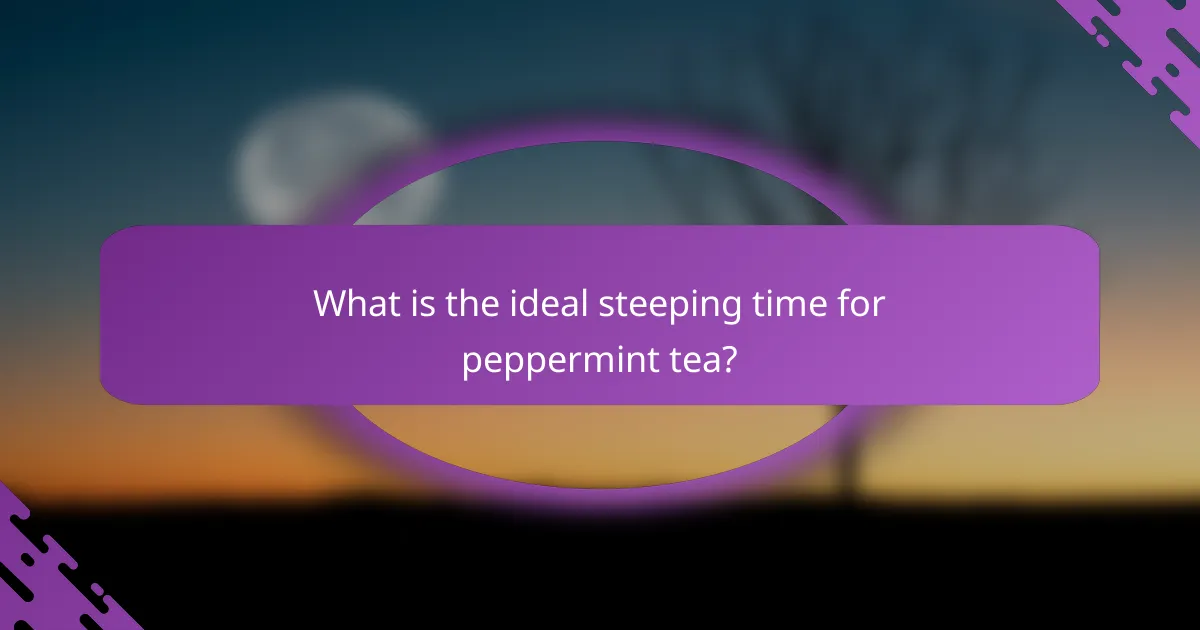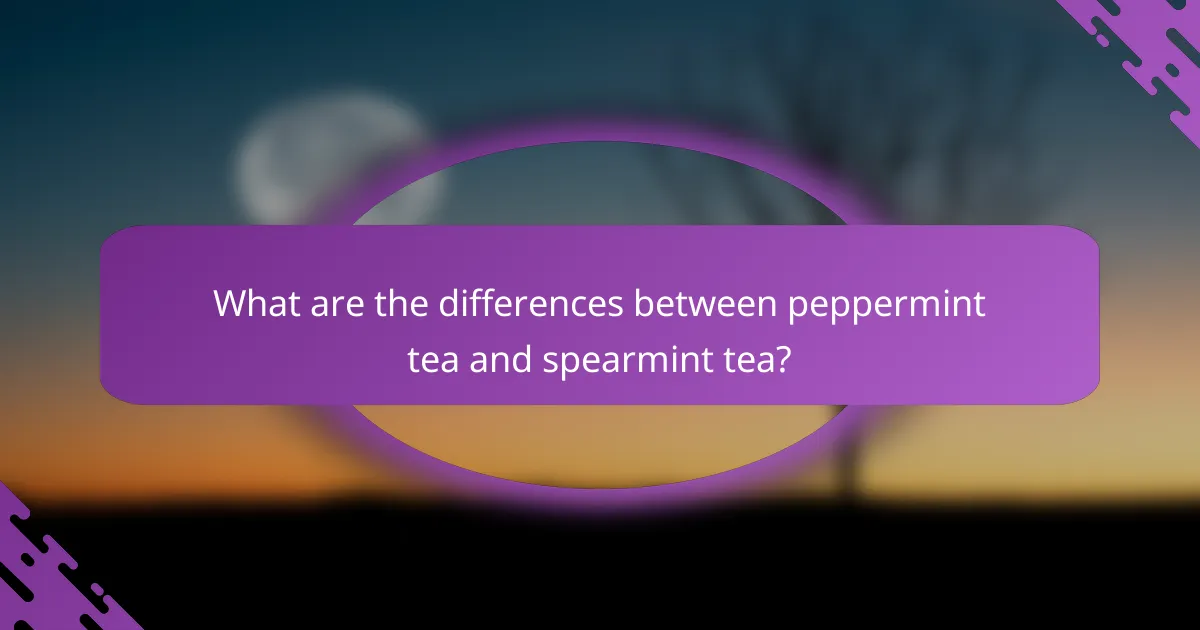Peppermint tea is a refreshing beverage that is best steeped for 3 to 5 minutes, allowing the leaves to fully release their essential oils and flavors. To enhance its natural taste, consider adding citrus, sweeteners, or fresh herbs. For serving, pair it with light snacks, use milk alternatives, or enjoy it iced for a delightful experience.

What is the ideal steeping time for peppermint tea?
The ideal steeping time for peppermint tea is typically between 3 to 5 minutes. This duration allows the leaves to release their essential oils and flavors, resulting in a refreshing and aromatic beverage.
3 to 5 minutes for optimal flavor
Steeping peppermint tea for 3 to 5 minutes strikes a balance between extracting flavor and avoiding bitterness. At around 3 minutes, the tea will have a milder taste, while 5 minutes will yield a stronger, more pronounced flavor. Adjusting the steeping time within this range can help you customize your tea experience.
Factors affecting steeping time
Personal preference is another key factor. Some may enjoy a lighter flavor and choose to steep for a shorter time, while others may prefer a robust taste and opt for longer steeping. Experimenting within the 3 to 5-minute range can help you find your perfect cup.
Recommended water temperature
The recommended water temperature for steeping peppermint tea is typically around 90 to 95 degrees Celsius (194 to 203 degrees Fahrenheit). Using water at this temperature helps to fully extract the essential oils from the leaves, enhancing the flavor and aroma of the tea.
Using water that is too hot can lead to over-extraction, resulting in a bitter taste. Conversely, cooler water may not extract enough flavor. A good practice is to bring water to a boil and then let it cool for a minute or two before pouring it over the tea leaves.

How can you enhance the flavor of peppermint tea?
Enhancing the flavor of peppermint tea can be achieved through several simple additions that complement its natural taste. Common enhancements include citrus, sweeteners, and fresh herbs, each contributing unique notes to the tea.
Adding lemon for brightness
Incorporating lemon into peppermint tea adds a refreshing brightness that balances the minty flavor. A slice of lemon or a squeeze of fresh lemon juice can elevate the overall taste profile.
Consider adding about a quarter to half a lemon per cup, depending on your preference. This addition not only enhances flavor but also provides a boost of vitamin C.
Incorporating honey for sweetness
Honey is a natural sweetener that pairs well with peppermint tea, adding a rich, floral sweetness. It can soften the tea’s sharpness while providing health benefits, such as soothing sore throats.
Start with a teaspoon of honey and adjust according to your taste. Keep in mind that local honey varieties may offer different flavor notes, so experimenting with different types can yield delightful results.
Using fresh peppermint leaves
Using fresh peppermint leaves instead of dried ones can significantly enhance the flavor of your tea. Fresh leaves provide a more vibrant and aromatic experience, making the tea taste more authentic.
For a single cup, use about 10-15 fresh leaves. Gently bruise the leaves before steeping to release their essential oils, which will intensify the flavor even further.

What are the best serving suggestions for peppermint tea?
The best serving suggestions for peppermint tea enhance its refreshing flavor and aroma. Consider pairing it with light snacks, using milk alternatives, or creating iced versions for a delightful experience.
Pairing with light snacks
Peppermint tea pairs well with light snacks that complement its refreshing taste. Consider serving it alongside cucumber sandwiches, fresh fruit, or light pastries. These options enhance the tea’s flavor without overwhelming the palate.
Avoid heavy or overly rich foods, as they can mask the delicate notes of peppermint. Instead, focus on simple, fresh ingredients that provide a contrast to the tea’s coolness.
Serving with milk alternatives
Creating iced peppermint tea

What are the health benefits of peppermint tea?
Peppermint tea offers several health benefits, primarily due to its natural compounds. It is known for aiding digestion, providing relief from headaches, and potentially improving respiratory function.
Digestive aid properties
Peppermint tea is widely recognized for its digestive aid properties. The menthol in peppermint can relax the muscles of the gastrointestinal tract, which may alleviate symptoms of bloating and gas. Drinking a cup after meals can help promote smoother digestion.
For optimal effects, steep peppermint tea for about 5 to 10 minutes. This allows the essential oils to infuse properly, enhancing its digestive benefits.
Soothing effects on headaches
Peppermint tea may provide soothing effects on headaches, particularly tension headaches. The menthol can help relax muscles and improve blood circulation, which may reduce headache intensity. Sipping this tea can be a natural remedy for mild headaches.
To maximize its effectiveness, consider inhaling the steam from the tea as you drink it. This can enhance the calming effects and may provide additional relief.
Potential respiratory benefits
Peppermint tea may offer potential respiratory benefits, as the menthol acts as a natural decongestant. It can help open airways, making it easier to breathe, especially during colds or allergies. Drinking this tea can provide a soothing effect on the throat as well.
For those experiencing respiratory discomfort, a warm cup of peppermint tea can be particularly beneficial. Consider adding honey or lemon for additional soothing properties and flavor enhancement.

What are the differences between peppermint tea and spearmint tea?
Peppermint tea and spearmint tea differ primarily in flavor and menthol content. Peppermint has a stronger, more intense flavor due to its higher menthol concentration, while spearmint offers a milder, sweeter taste.
Flavor profile comparison
Peppermint tea is characterized by its bold, cooling flavor, which can be quite refreshing. The high menthol content gives it a sharpness that many find invigorating. In contrast, spearmint tea is sweeter and less intense, making it a popular choice for those who prefer a gentler mint experience.
When brewing, peppermint tea typically has a more pronounced aroma and taste, while spearmint tea can be enjoyed for its subtlety. This difference in flavor profiles can influence their use in various beverages and dishes.
Health benefits differences
Peppermint tea is often praised for its digestive benefits, helping to relieve symptoms like bloating and indigestion. Its higher menthol content may also provide relief from headaches and sinus congestion.
Spearmint tea, on the other hand, is known for its calming properties and may aid in reducing stress and anxiety. It is also believed to have hormone-balancing effects, particularly beneficial for women.
Usage in culinary applications
Peppermint tea is frequently used in desserts, cocktails, and as a flavor enhancer in savory dishes. Its strong flavor can stand up to rich ingredients, making it versatile in various recipes.
Spearmint tea is commonly used in salads, sauces, and beverages like mojitos or mint juleps. Its sweeter profile complements fruits and lighter dishes, making it a favorite in summer recipes.

How to choose the best peppermint tea brand?
To choose the best peppermint tea brand, prioritize quality indicators such as organic certifications, freshness, and customer feedback. These factors can significantly influence the flavor and health benefits of the tea.
Look for organic certifications
Organic certifications ensure that the peppermint tea is grown without synthetic pesticides or fertilizers, which can enhance both flavor and health benefits. Look for brands that are certified by recognized organizations, such as USDA Organic or EU Organic.
Choosing organic peppermint tea can also support sustainable farming practices, making it a better choice for environmentally conscious consumers. Check the packaging for these certifications to ensure you are getting a high-quality product.
Check for freshness indicators
Freshness is crucial for maximizing the flavor and aroma of peppermint tea. Look for packaging that includes a harvest or best-by date to gauge the tea’s freshness. Ideally, the tea should be consumed within a year of its harvest date for optimal taste.
Additionally, consider brands that use airtight packaging to preserve the tea’s freshness. This can help prevent exposure to moisture and light, which can degrade the quality over time.
Read customer reviews
Customer reviews provide valuable insights into the taste and quality of peppermint tea brands. Look for feedback that highlights the flavor profile, aroma, and overall satisfaction of previous buyers. This can help you identify brands that consistently deliver high-quality tea.
Pay attention to reviews that mention specific characteristics, such as the strength of the peppermint flavor or any aftertaste. This information can guide you in selecting a brand that aligns with your personal preferences.
